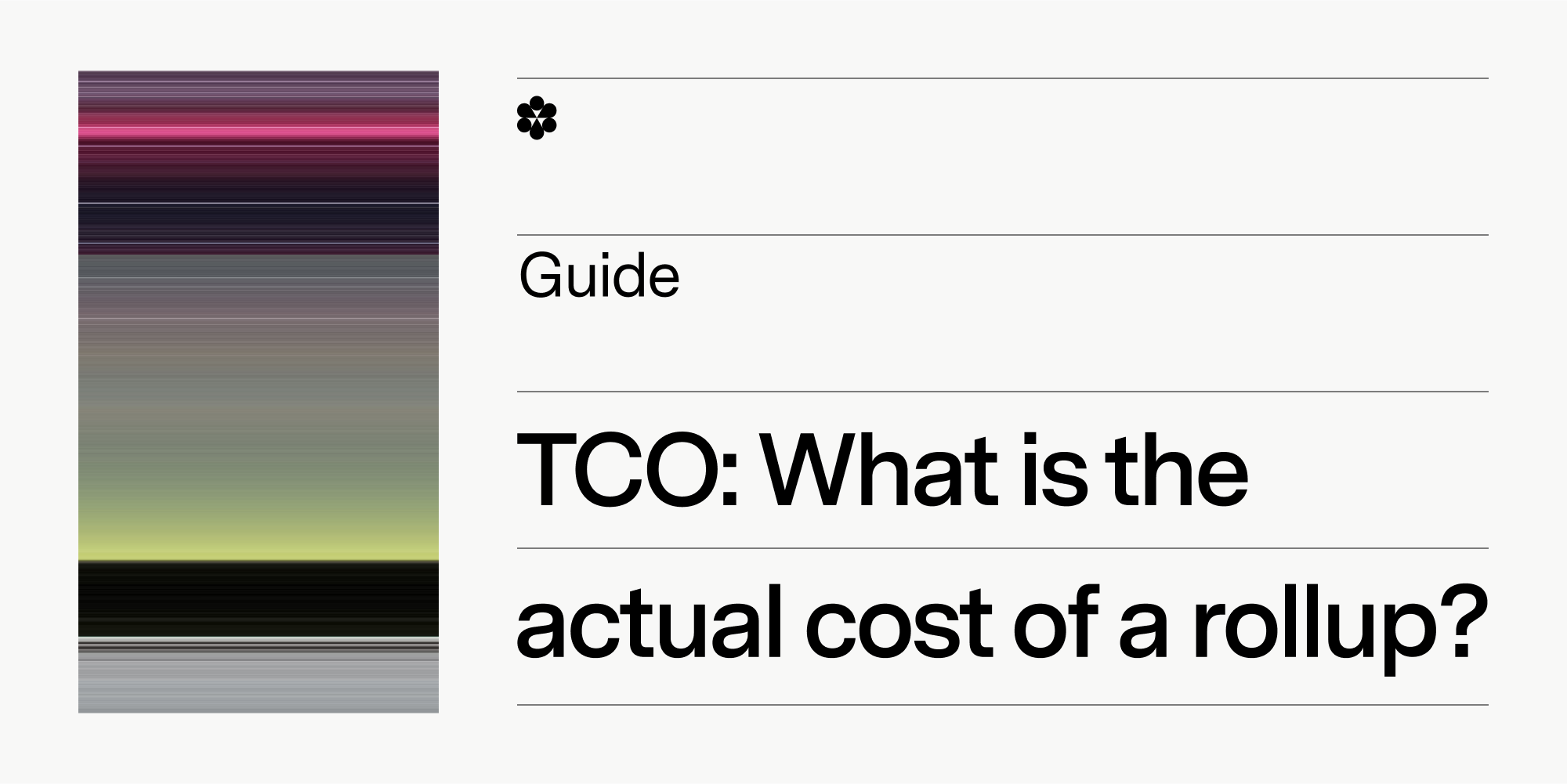What Running a Rollup Actually Costs: Total Cost of Operations (TCO)
Rollup teams need to evaluate the cost to run their chain holistically. That's where total cost of operations (TCO) comes in.

There’s a misconception that rollups are an expensive luxury technology. Some have claimed that they cost as much as $10 million to launch and run.
This is incorrect. On Conduit, it costs just $36,000 per year to run a rollup on mainnet, plus onchain DA costs. Yes, you’ll pay more if you want to integrate more tooling for interoperability, oracles, native stablecoin issuance, and the like. But the total shouldn’t exceed a few hundred thousand per year for most rollups.
However, framing the rollup cost question as a simple list of line items is the wrong way to approach it in the first place. And it will become even more wrong as rollup infrastructure continues to become cheaper and more commoditized.
The best rollup teams instead think about everything in terms of total cost of operations (TCO). What is the full cost to run a rollup, not just in dollars, but in operational overhead, uptime vs. downtime, and the agility with which your infrastructure allows you to attack new opportunities?
At Conduit, our goal is to lower TCO by so much that using a free rollup platform over us would be a net negative for the business, and we’re confident we’re achieving that goal.
Here’s why.
What is total cost of operations (TCO)?
TCO is a framework for evaluating a business’ expenses in a holistic, comprehensive way.
Businesses are complicated – especially onchain businesses. You can’t just add up the dollars spent on every vendor, employee, and investment to get a true understanding of what it actually costs to run that business.
Here’s an analogy: Let’s say you were opening a cafe, and you were evaluating two coffee bean suppliers: A new, unproven but ultra cheap supplier charging $5 per pound, and a battle-tested, high-reputation supplier charging $10 per pound. You choose the cheaper supplier to save money, but their delivery ends up being late, and you have to delay opening by three hours. On paper, you still cut costs 50%, but you lost out on an unknown number of sales during those three hours, and you’ve also suffered reputational damage – the customers you had to turn away during the delay may never come back. You can’t measure the missed opportunity exactly, but the TCO of $5 plus all the business you’ve lost out on outweighs the $10 you could’ve paid for a better supplier.
The point here isn’t simply that you should pay more for better service. It’s that you need to think holistically about how every cost actually impacts your business. That’s what TCO addresses.
What goes into rollup TCO?
Rollup TCO is made up of many direct and indirect costs. Keep in mind that this list isn’t comprehensive, and that the impact of each item will be different depending on the rollup’s use case and desired audience.
Direct costs (i.e. things you actually fork over dollars or ETH for):
- Developer salaries
- Vendor costs
- Data availability
- Cost to list on exchange (if you have a token)
- Marketing and customer acquisition costs
Indirect costs (i.e. things you don’t pay for but nonetheless lower your bottom line):
- Time to launch, including time to pick and optimize your rollup tech stack
- Time to integrate new partners
- Time to switch to a different partner if the first one you integrated is a bad fit (oh, the stories we've heard…)
- Time to implement new upgrades
- Any downtime
- RPC failure or instability
- Latency and its effects on UX
- Operational overhead, e.g. time and effort to distribute sequencer fees, or manage governance, or try and get two critical partners to make their tools compatible with one another, etc.
Our job at Conduit is to reduce these costs as much as possible so that our rollups can achieve the lowest possible TCO. The direct costs are the easy part. Indirect costs are more difficult to lower, as doing so requires technical expertise and industry knowledge. What’s the best rollup framework for a given use case? Who from these two integration partners do we need to get in a Telegram channel to make the tools work together? What’s the one line of code in the L1 smart contract we can modify to make this rollup perform like it should? Not many teams are equipped to answer these questions.
How Conduit reduces TCO for rollups
Reducing TCO for rollups as an infrastructure partner requires partnership, a true understanding of each rollup’s unique use case, and deep onchain expertise. Here are a few examples of how we’ve worked with our customers to reduce TCO.
Derive: More gas, more positions for traders. Better DA, more runway.
Derive is one of the biggest, fastest-growing derivatives DEXs in the Ethereum ecosystem. Soon after they launched their rollup with Conduit, we upgraded Derive’s RPC nodes to raise their gas limit from 30 to 400 Mgas/s. That increase means Derive traders can take twice as many active positions.
“2x may not sound like much but it enables market makers to be many multiples more capital efficient because of the way portfolio margin works. That brings more market makers to our platform, which means the spreads can get tighter and tighter for users,”
- Derive Head of Engineering Josh Kim
Derive’s derivatives use case meant that a seemingly simple gas limit increase kicked off a flywheel effect bringing in more market makers and retail traders. In other words, an infrastructure tweak lowered Derive’s TCO by indirectly lowering user acquisition costs.
Another important tweak: Switching Derive from Ethereum DA to Celestia. DA costs were burning up Derive’s runway. We switched Derive to Celestia and immediately the chain’s DA costs fell 95%, from 1.3 ETH per day to 0.06 ETH.
“At this rate, we were going to run out of money,” said Kim. “Conduit moved us to Celestia in under two weeks, it was totally painless.”
- Josh Kim
The obvious TCO reduction here is the huge decrease in DA costs. But the speed of the switch was important too. Even one more week would have cost Derive another 8.7 ETH – roughly $22,000 USD based on ETH prices at the time of the switch (equivalent to seven months of Conduit service).
Zora Network: Autoscaling RPCs let Zora go viral
Zora enables creators to get paid onchain by deploying mintable NFTs on an Instagram-like feed. Conduit provides the platform for Zora’s rollup, and also runs the RPC nodes that allow the Zora app to function. It’s crucial that those RPCs perform and remain stable, especially when traffic surges due to big mints.
“Conduit Nodes allow us to always maintain performance so that our biggest mints go off without a hitch,” said Tyson Battistella, CTO of Zora.
One such mint was during Zora’s Total Solar Eclipse NFT, when RPC requests shot up to over 12,900 per second. Thanks to our autoscaling capabilities, Zora maintained performance and took full advantage of this viral mint. In TCO terms, that meant Zora made over $14,000 in fees during the day of the mint and two following days. Zora also had its biggest day ever for active users at more than 92,000, many of whom continued to use the network and afterwards – they likely would have lost some of them had the eclipse mint not gone smoothly.
Proof of Play: Partnering to break scaling barriers
Proof of Play is the studio behind Pirate Nation, the biggest onchain game operating today. Conduit helped Proof of Play transition Pirate Nation to its own rollup after gas fees on shared blockchains proved to be unsustainable at just a few hundred users, reaching as high as $70,000 per month. We worked with Proof of Play to deploy an Arbitrum L3 that costs Proof of Play as little as 0.04 ETH per month in DA.
Since then, we’ve helped Proof of Play scale to support over 10,000 concurrent players, developing our enhanced G2 Sequencer alongside them to make that growth possible. Later, we worked with Proof of Play to become one of the first apps to run concurrently on multiple appchains to enable even more growth.
“No one else has scaled an onchain game this fast or this far. Conduit is at the forefront of this with us, learning what breaks and when.”
- Matt Van, Proof of Play Head of Engineering
From a TCO standpoint, Conduit has helped make Proof of Play’s vision for a fully onchain game economically feasible – first by turning onchain costs from an unsustainable expense to a negligible one, and then by finding new ways to give the app more throughput with each scaling barrier.
The cost to run a rollup depends on the quality of your partners
There are two things you should take away from this blog:
- Rollups don’t cost $10 million per year to run
- TCO is determined by the quality of your partners
The first point is easy: While launching a rollup may once have been a multi-million dollar endeavor, costs have fallen rapidly in the last few years and will continue to do so.
The second point requires a slight shift in how you think about expenses, but it’s a shift that the best teams are embracing to great effect. The actual cost of running your chain, including the cost of missed opportunities and time saved by finding the right solutions faster, is largely determined by the infrastructure teams you partner with. It takes a team with deep expertise and an ability to translate your business needs into technical decisions to make your rollup economically successful.
Want to launch your own rollup? Contact us and learn how.

